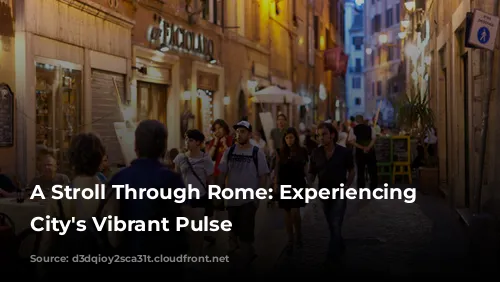Rome, a city steeped in history and brimming with life, offers a unique blend of ancient grandeur and modern vibrancy. It’s a city that invites you to slow down, soak in the atmosphere, and discover its captivating spirit.
The Art of the Stroll
In Rome, the passeggiata, a leisurely evening stroll, is a cherished ritual. It’s more than just a walk; it’s a social event where people connect, admire each other, and relish the energy of the city. In Rome, this tradition is known as the “struscio,” a term that evokes a sense of rubbing shoulders with the city’s diverse crowds.
This tradition reflects the Italian passion for enjoying life’s simple pleasures. You’ll see young Italians, many of whom live with their parents, embracing the latest trends and making the most of their time. In the bustling downtown area, especially along Via del Corso, the iconic Vespa motor scooter is a symbol of urban style. It’s a place to see and be seen, where fashion is as important as the destination.
From “Bella” to “Buono”
In smaller towns, the passeggiata is often associated with romantic encounters, with boys and girls exchanging compliments like “bella” and “bello” (“pretty” and “handsome”). In Rome, however, the focus shifts to a celebration of the city’s culinary delights. The admiration is expressed through “buona” and “buono” (“tasty”), highlighting the importance of good food and a vibrant social scene.
The struscio transforms the streets into a lively stage, with shoppers, onlookers, and young couples all vying for attention. Police barricades keep traffic at bay, allowing the crowds to flow freely from Piazza del Popolo to Via Condotti, culminating at the grand Spanish Steps. It’s a scene that captures the essence of Rome’s social fabric.
Beyond the Tourist Trail
While many tourists are content to experience Rome’s art and culture through museums and performances, I crave a deeper immersion in the city’s living culture. I want to experience it “in situ,” engulfed in the authentic rhythms of daily life. Walking alongside the locals, you gain a perspective that goes beyond mere observation. It’s about experiencing the city’s soul, its heartbeat.
The Pope’s Audience: A Spiritual Tailgate Party
The next day, I found myself in a completely different atmosphere, caught in the midst of a large gathering in St. Peter’s Basilica for Mass. The presence of the Pope, accompanied by the striking Swiss Guard, transformed the basilica into a stage for a spiritual spectacle. The Swiss Guard, with their colorful uniforms and imposing weaponry, were more than just ceremonial figures; they were a constant reminder of security and order.
After Mass, the crowds spilled out into St. Peter’s Square, where a massive video screen broadcast the event for those who couldn’t make it inside. The scene was reminiscent of a Catholic tailgate party, with groups from all over the world celebrating the Pope’s presence with boisterous cheers, live music, and shared meals. It was a testament to the power and unifying presence of the Catholic Church.
The highlight of the event was the appearance of the Pope at the window of his study. The crowd erupted in cheers as he delivered his message, followed by a wave of goodbyes as the worshippers dispersed back into the city.
Walking in the Footsteps of History
Leaving St. Peter’s, I crossed the Ponte Sant’Angelo, a bridge as old as the papacy itself. As I walked along, I couldn’t help but remember the tragic event of 1450, when a surge of worshippers overwhelmed the bridge, causing 200 to fall into the Tiber River. The modern stone railing serves as a sobering reminder of history’s fragility and the importance of safety in large crowds.
Piazza Navona: A Mosaic of Roman Life
My journey continued to Piazza Navona, a vibrant square where the fountains designed by Bernini are a constant source of wonder. This bustling space is a microcosm of Roman life, a tapestry woven with families, street musicians, artists, and entrepreneurs. The air buzzes with activity, from the tantalizing scent of gelato to the shouts of street vendors. It’s a place to soak in the energy of the city, to taste the flavors of life, and to simply enjoy the human spectacle.
The Walls Speak: Graffiti as a Voice of the People
Around the corner, I discovered an old statue, its surface covered in graffiti. This tradition, stretching back centuries, reflects the desire of the people to express themselves, even anonymously. The messages, scrawled in a mix of humor and frustration, offer a glimpse into the minds of Romans, from complaints about traffic congestion to scathing critiques of politicians.
Rome’s Enduring Legacy
In the heart of Rome, the ancient Pantheon, once a Roman temple, now stands as a church, filled with people and music. I sat down across the street, enjoying a cup of coffee – an art form in itself – while contemplating the city’s cultural legacy. The Doria Pamphilj Villa, a former ducal residence, offered a concert featuring a string quartet illuminated by chandeliers amidst masterpieces by Raphael, Caravaggio, and Velázquez.
It’s an experience that encapsulates the essence of Rome: a city where history and modernity intertwine, where the past and present converge, and where every corner offers a new story waiting to be discovered. As I prepared to immerse myself in the villa’s cultural offerings, I felt a sense of gratitude for the opportunity to experience this city, not just as a tourist, but as a traveler seeking to understand its vibrant pulse, its beating heart.
